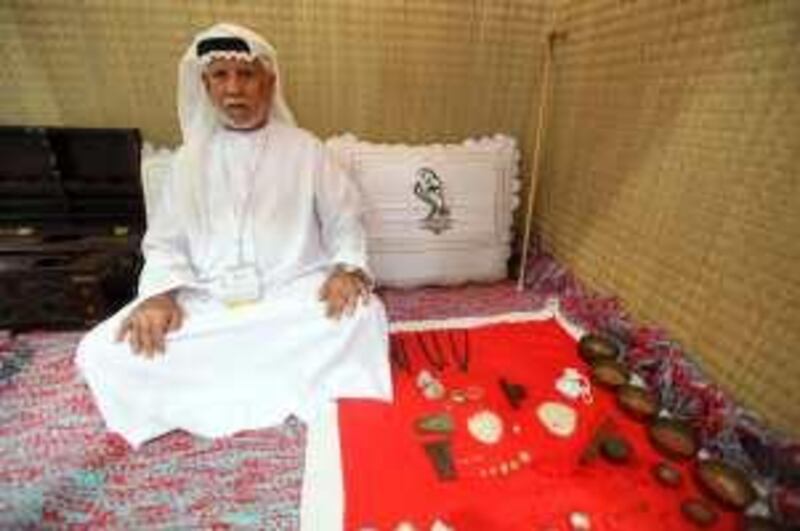ABU DHABI // The recent bad weather may have taken many people by surprise, but Khamees bin Zaal al Rumaithy was not one of them. From last week until the first week of April, he says, unsettled weather in the region is inevitable. It is the time of "Jawlat al Riyah" the touring or wandering winds.
He is confident there will be another storm, though smaller, towards the end of March. How does he know? Because Mr al Rumaithy, 86, has spent his life watching weather patterns - as did his ancestors. Most of us get our weather warnings from newspapers or the electronic media. Mr al Rumaithy has far older sources of information - the wind, the stars and the rhythms of an ancient calendar. A former sailor and pearl diver, Mr Rumaithy said that in the pre-oil history of the region, "sudden changes in weather would cost you your life, and so we paid a lot of attention to mother nature and her moods".
The art of predicting weather was handed down to him by the elders of the coastal tribes in Abu Dhabi. Their knowledge of the many clues in nature to the impending weather patterns became his. This week, as the star attraction of a small display at the Abu Dhabi International Book Fair, and surrounded by the tools of his former trades, Mr al Rumaithy shared with visitors his stories of the old ways of life.
While his eyesight and hearing may not be as keen as they once were, he still likes to gaze at the sky and listen to the winds to gauge the moods of the seasons and predict the changes that will accompany them. The brilliance of a certain star, the hue of the moon, barely perceptible changes in the strength and direction of the wind - such subtle clues may be lost on the average landsman. But, together with the seasonal rhythms with which all here were once intimately familiar, they are all the former seaman needs to predict the way the weather will unfold.
"It has all been calculated and charted out many centuries ago," he said. "While there are sometimes some surprises, our old methods are quite reliable." All of his knowledge, like so much of the heritage of the region, is handed down by word of mouth. "We never used to write anything down, we just memorised poems with the names of the stars and winds in them to guide us throughout the year as we travelled through the sea or along the desert."
Bedouin in the desert used different stars and calculations than their counterparts in the mountains and along the coast. But all depended on a four-season calendar - al drour - that was defined by the stars and their courses through the heavens. The southern star, Suhail, also known as Canopus, appears in the sky in mid-August every year and, in the Arabian Peninsula, remains visible until late winter. Its appearance promised the end of the hot season, Mr al Rumaithy said.
"As pearl divers, we would always welcome the sight of Suhail as it brought us luck as we fished for pearls," he said. It was not only the pearl fishermen who relied on the rhythms of the stars. Such observations helped fishermen to know when to fish and farmers when to plant. The star calendar was also used as a guide for social events, providing auspicious times for marriages and battles. Mr al Rumaithy does not subscribe to the belief that the world and the region are witnessing radical shifts in weather patterns.
"The pattern of our seasons and the weather hasn't really changed much since I was a child, with perhaps a bit less than usual rain in the past two to three years," he said. "I don't understand all this surprise and fuss when storms arrive because we already knew they would be coming around this time." Traditionally, the last big storm before summer takes place in the last week of April, just before the disappearance of the Thuraya, the Arabic name for the Pleiades star cluster, better known, perhaps, as the Seven Sisters.
"It is a difficult period of about 40 days that brings with it storms," he said. "Sailors have to be careful." Some modern men concede that Mr al Rumaithy may know a thing or two about weather. The Emirates Heritage Club often calls on him to oversee boat races and advise on the best days for fleets to go to sea. He feels little affinity for the modern approach to the weather: "I find nothing more irritating then listening to a weather news channel announcer making mistakes with the names and directions of the winds, and describing every storm like it is worse than the one before it. I am old, yes, but I still know my winds."
Professor Hassan al Naboodah, a historian at UAE University in Al Ain who has been collecting data about the nation's heritage, including the traditional ways of climate prediction, said he had been surprised at the accuracy of Mr al Rumaithy's predictions. "He isn't always 100 per cent accurate, but neither are modern weather forecasts," said Prof al Naboodah, who has been documenting Mr al Rumaithy's observations as part of his research.
"The old calendar does seem to give us a good overall picture of the weather patterns here." Unfortunately, Mr al Rumaithy, who has outlived his three children and wife and has 44 grandchildren, feels that the knowledge that has survived for generations will probably die with him, to survive only in researchers' archives. "With all the new tools and technology, no one bothers to look at the stars any more for answers," he says.
rghazal@thenational.ae






